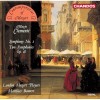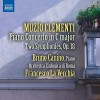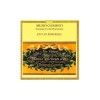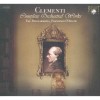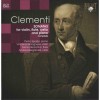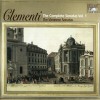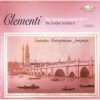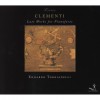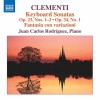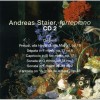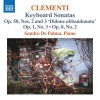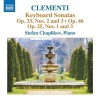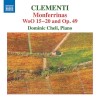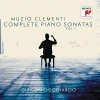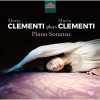传记
Muzio Clementi (24 January 1752, Rome – 10 March 1832, Evesham, Worcestershire, England) was a celebrated composer, pianist, pedagogue, conductor, music publisher, editor, and piano manufacturer. Born in Italy, he spent most of his life in England. He is best known for his piano sonatas, and his collection of piano studies, Gradus ad Parnassum. Nineteenth century enthusiasts lauded Clementi as "the father of the pianoforte", "father of modern piano technique", and "father of Romantic pianistic virtuosity".
Encouraged to study music by his father, he was sponsored as a young composer by Sir Peter Beckford, a wealthy Englishman who took him to England to advance his studies. He soon became known as one of the great piano virtuosi, touring Europe numerous times from his long time base in London. It was on one of these occasions in 1781 that he famously engaged in a piano competition with Wolfgang Amadeus Mozart.
Influenced by Domenico Scarlatti's harpsichord school and Haydn's classical school and by the stile galante of Johann Christian Bach and Ignazio Cirri, Clementi developed a fluent, technical legato style which he passed on to an entire generation of pianists, including John Field, Johann Baptist Cramer, Ignaz Moscheles, Giacomo Meyerbeer, Friedrich Kalkbrenner, Johann Nepomuk Hummel and Carl Czerny. He was a notable influence on Ludwig van Beethoven.
Clementi also produced and promoted his own brand of pianos and was a notable music publisher. It was thanks to this activity that many compositions by contemporary and earlier artists have stayed in the repertoire. Though the European reputation of Muzio Clementi was second only to Joseph Haydn in his day, his reputation languished for much of the 19th and 20th centuries.
Muzio Filippo Vincenzo Francesco Saverio Clementi (baptized Mutius Philippus Vincentius Franciscus Xaverius), was born in Rome, Italy on January 24, 1752, and the following day baptized in the local church of S. Lorenzo in Damaso. He was the eldest of the seven children of Nicolo Clementi (1720–1789), a noted silversmith, and Madalena, née Caisar (Magdalena Kaiser), who was Swiss. Nicolo soon recognized Muzio’s musical talent and arranged for private musical instruction with a relative, Antonio Baroni, the maestro di cappella at St. Peter’s Basilica.
At the age of seven Clementi commenced studies in figured bass with the organist Cordicelli, followed by voice lessons from Giuseppe Santarelli. A few years later, probably at 11 or 12, he was given counterpoint lessons by Gaetano Carpani. By age 13 Clementi had already composed an Oratorio, Martitio de’ gloriosi Santi Giuliano, and a mass. When he was 14, in January of 1766, he became organist of the parish San Lorenzo in Dámaso.
In 1766, Sir Peter Beckford (1740–1811), a wealthy Englishman and cousin of the novelist William Thomas Beckford, twice Lord Mayor of London, visited Rome. He was impressed by the young Clementi's musical talent, and negotiated with his father to take him to his estate, Steepleton Iwerne, north of Blandford Forum in Dorset, England. Beckford agreed to provide quarterly payments to sponsor the boy's musical education until he reached age 21. In return, he was expected to provide musical entertainment. For the next seven years Clementi lived, performed, and studied at the estate in Dorset. During this period, it appears, Clementi spent eight hours a day at the harpsichord, practising the works of Johann Sebastian Bach, Carl Philipp Emanuel Bach, George Frideric Handel, Domenico Scarlatti, Alessandro Scarlatti and Bernardo Pasquini. The only compositions dated to this period are the Sonatas WO 13 and 14 and the Sei Sonate per clavicembalo o pianoforte, Op. 1.
In 1770 Clementi made his first public performance as an organist. The audience was reported to be impressed with his playing, thus beginning one of the outstandingly successful concert pianist careers of the period.
In 1774, Clementi was freed from his obligations to Peter Beckford. During the winter of 1774–1775 he moved to London, making his first appearance as a harpsichordist in a benefit concert on April 3, 1775. There he made several public appearances as a solo harpsichordist at benefit concerts for two local musicians, a singer and a harpist, and served as conductor (from the keyboard) at the King's Theatre (Her Majesty's Theatre), Haymarket, for at least part of this time. His popularity grew in 1779 and 1780, due largely to the run-away sales of his newly-published Opus 2 Sonatas. His fame rose quickly, and there was enthusiastic talk in musical circles that he was the greatest piano virtuoso of the day, possibly of all time.
Clementi started a three year European tour in 1780, travelling to Paris, France where he performed for Queen Marie Antoinette, Munich, Germany, and Salzburg, Austria. In Vienna, he agreed to enter a musical contest with Mozart for the entertainment of Holy Roman Emperor Joseph II and his guests. On 24 December 1781, at the Vienese court. The composers were called upon to improvise and to perform selections from their own compositions. The Emperor diplomatically declared a tie.
January 12, 1782, Mozart reported to his father: "Clementi plays well, as far as execution with the right hand goes. His greatest strength lies in his passages in 3rds. Apart from that, he has not a kreuzer’s worth of taste or feeling - in short he is a mere mechanicus." In a subsequent letter, he wrote: "Clementi is a charlatan, like all Italians. He marks a piece presto but plays only allegro."
Clementi's impressions of Mozart, by contrast, were enthusiastic. Much later, the pianist Ludwig Berger recalled him saying: "Until then I had never heard anyone play with such spirit and grace. I was particularly overwhelmed by an adagio and by several of his extempore variations for which the Emperor had chosen the theme, and which we were to devise alternately."
Despite later attempts to portray the two as rivals, there's no evidence that their meeting was not cordial. At the time Clementi was exploring a more virtuosic and flamboyant style, and this might explain Mozart's disparaging attitude. One of the pieces he performed was his Op.11 toccata, a display piece full of parallel thirds. It would appear that later on Mozart's opinion might have undergone some modification. As noted by Hermann Abert in his "W.A.Mozart," the set of variations K.500 of 1786 "includes a handful of novel pianistic effects that are foreign to Mozart's earlier style and that clearly reflect the influence of Clementi."
Interestingly, Mozart used the opening motive of Clementi's B-flat major sonata (Op. 24, No. 2) in his overture for "Die Zauberflöte." It was not unusual for composers to borrow from one another, and this might be considered a compliment. Though Clementi noted in subsequent publications of his sonata that it had been written ten years before Mozart's opera--presumably to make clear who was borrowing from whom--Clementi retained an admiration for Mozart, as reflected in the large number of transcriptions he made of Mozart's music, among which is a piano solo version of the "Zauberflöte" overture.
From 1783, and for the next twenty years, Clementi stayed in England playing the piano, conducting, and teaching. Several of his students attained a fair amount of fame for themselves: Johann Baptist Cramer, Ignaz Moscheles, Therese Jansen Bartolozzi, Ludwig Berger (who went on to teach Felix Mendelssohn), and John Field (who, in his turn, would become a major influence on Frédéric Chopin).
In 1790, Clementi made the decision to give up his performing career, possibly in order to bolster his reputation as a composer. In 1798 he took over the firm Longman and Broderip at 26 Cheapside, initially with a James Longman, who left in 1801. Clementi also had offices at 195 Tottenham Court Road from 1806. The publication line, 'Clementi & Co, & Clementi, Cheapside' appears on a lithograph, 'Music'by W Sharp after J Wood, circa 1830s.
He also began manufacturing pianos, but in March 1807 the warehouses occupied by his new firm were destroyed by a fire, resulting in a loss of about ₤40,000. That same year, he struck a deal with Ludwig van Beethoven, one of his greatest admirers, that gave him full publishing rights to all of Beethoven's music in England. His reputation as an editor and interpreter of Beethoven's music is at least as great as his reputation as a composer, though he's been criticized for some editorial work, such as making harmonic "corrections" to some of Beethoven's scores.
That Beethoven, in his later life, started to compose chamber music specifically for the British market may have been related to the fact that his publisher was living in London.
In 1810, Clementi stopped concertizing in order to devote his time to composition and piano making. On 24 January 1813, Clementi together with a group of prominent professional musicians in England founded the "Philharmonic Society of London", which became the Royal Philharmonic Society in 1912. In 1813 Clementi was appointed a member of the Swedish Royal Academy of Music.
Meanwhile, his pianoforte business had flourished, affording him an increasingly elegant lifestyle. As an inventor and skilled mechanic, he made important improvements in the construction of the piano, some of which have become standard in instruments to this day.
At the end of 1816 Clementi made another trip to the continent to present his new works, particularly at the Concerts Spirituels in Paris. He returned to London in June 1818, after stopping off in Frankfurt. In 1821 he once again returned to Paris, conducting his symphonies in Munich and Leipzig. In London he was becoming widely acclaimed as a symphonist: in 1824 his symphonies were featured in five of the six programs at the 'Concerts of Ancient and Modern Music' at the King's Theatre.
In 1826 Clementi completed his very large collection of keyboard studies, Gradus ad Parnassum, and set off for Paris with the intention of publishing the third volume of the work simultaneously in Paris, London and Leipzig. After staying in Baden and most likely making another visit to Italy, he returned to London in the autumn of 1827.
On 17 December 1827, a large banquet was organised by Johann Baptist Cramer and Ignaz Moscheles in his honor at the Hotel Albion. Moscheles, in his diary, says that on that occasion Clementi improvised at the piano on a theme by George Frideric Handel. In 1828 he made his last public appearance at the opening concert of the Philharmonic Society. In 1830 he retired from the Society.
Clementi moved outside Lichfield, Staffordshire, in 1830, and spent his final years in Evesham, Worcestershire. On 10 March 1832, after a short illness, he died. He was eighty years old. On 29 March 1832, he was buried at Westminster Abbey. Accompanying his body were three of his famous students: Johann Baptist Cramer, John Field and Ignaz Moscheles. He had been married three times and is said to have had four children.
As a composer of Classical piano sonatas, Clementi was among the first to create keyboard works expressly for the capabilities of the pianoforte. Acclaimed as the father of the pianoforte and modern piano technique, this complex and influential musician was also the first virtuoso on the instrument. Clementi established the modern piano technique and influenced generations of virtuosi to come.
Of Clementi's playing in his youth, Moscheles wrote that it was "marked by a most beautiful legato, a supple touch in lively passages, and a most unfailing technique." Domenico Scarlatti may be said to have closed the old and Clementi to have founded the newer school of technique on the piano.
Among Clementi's compositions the most remarkable are sixty sonatas for pianoforte, and the great collection of Etudes called Gradus ad Parnassum. Debussy's piece "Doctor Gradus ad Parnassum" (the first movement of his suite Children's Corner) makes playful allusion to it. Similarly his sonatinas are still popular for piano students everywhere. Erik Satie, a contemporary of Debussy, would later parody these sonatinas (specifically the Sonatina Op. 36, No. 1) in his Sonatine bureaucratique.
Clementi composed almost 110 piano sonatas. Some of the earlier and easier ones were later classified as sonatinas after the success of his Sonatinas Op. 36, and continue to be popular pedagogical pieces in piano education. However, most of Clementi's sonatas are more difficult to play than those of Mozart, who wrote in a letter to his sister that he would prefer her not to play Clementi's sonatas due to their jumped runs, and wide stretches and chords, which he thought might ruin the natural lightness of her hand.
In particular it is worth noting that Clementi also composed among the first minor key piano sonatas, in a period in which the listeners expected mostly joyful major key music.
In addition to the piano solo repertoire, Clementi wrote a great deal of other music, including several recently pieced together, long worked on but slightly unfinished symphonies that are gradually becoming accepted by the musical establishment as being very fine works. A likely reason that these later works were not published in Clementi's lifetime is that he kept revising them. While Clementi's music is hardly ever played in concerts, it is becoming increasingly popular in recordings.
Clementi's influence extended well into the 19th century, with composers using his sonatas as models for their keyboard compositions. Ludwig van Beethoven, in particular, had the highest regard for Clementi. Beethoven often played Clementi sonatas and often a volume of them was on his music stand. Beethoven recommended these works to many people including his nephew Karl. The most accurate description of Beethoven's regard for Clementi's music can be found in the testimony of his assistant, Anton Schindler, who wrote "He (Beethoven) had the greatest admiration for these sonatas, considering them the most beautiful, the most pianistic of works, both for their lovely, pleasing, original melodies and for the consistent, easily followed form of each movement. The musical education of his beloved nephew was confined for many years almost exclusively to the playing of Clementi sonatas." (Beethoven as I Knew Him, ed. Donald M. McArdle, trans. Constance Jolly, Chapel Hill and London, 1966). Schindler continues with reference to Beethoven's fondness for Clementi's piano sonatas: "For these he had the greatest preference and placed them in the front rank of pieces appropriate to the development of fine piano playing, as much for their lovely, pleasing, fresh melodies as for the well knit, fluent forms of all the movements." In Moscheles edition of Schindler's biography he quotes Schindler as follows: "Among all the masters who have written for pianoforte, Beethoven assigned to Clementi the very foremost rank. He considered his works excellent as studies for practice, for the formation of a pure taste, and as truly beautiful subjects for performance. Beethoven used to say...'They who thoroughly study Clementi, at the same time make themselves acquainted with Mozart and other composers; but the converse is not the fact.' "
Carl Czerny also had the highest regard for Clementi's piano sonatas and used them successfully in his teaching of Franz Liszt. Czerny referred to Clementi as "the foremost pianist of his time."
Vladimir Horowitz developed a special fondness for Clementi's work after his wife, Wanda Toscanini, bought him Clementi's complete works. Horowitz, who recorded four of Clementi's Sonatas along with shorter pieces, compared some of them to the best works of Beethoven. The restoration of Clementi's image as an artist to be taken seriously is not least due to his efforts and today to Andreas Staier, Andrea Coen and Costantino Mastroprimiano.
Being a contemporary of Mozart and Beethoven, Clementi to this day is revered as one of the greatest piano players and remains a prominent figure in the history of music, as well as in the development of the sonata form.
With ministerial decree dated 20 March 2008, the Opera Omnia of the composer Muzio Clementi was promoted to the status of Italian National Edition. The steering committee of the National Edition consisting of the scholars Andrea Coen (Rome), Roberto De Caro (Bologna), Roberto Illiano (Lucca — President), Leon B. Plantinga (New Haven, CT), David Rowland (Milton Keynes, UK), Luca Sala (Paris/Poitiers, Secretary and Treasurer), Massimiliano Sala (Pistoia, Vice-President), Rohan H. Stewart-MacDonald (Cambridge, UK) and Valeria Tarsetti (Bologna).
The critical edition of the complete works of Clementi, published by Ut Orpheus Edizioni of Bologna, will consist of 15 volumes: the first two will contain vocal and orchestral music respectively, five volumes will be devoted to the chamber music, two volumes to the keyboard works, and two volumes to the didactic works. Another three volumes will contain: 1.) the doubtful works, the arrangements and transcriptions of Clementi; 2.) the correspondence; 3.) a thematic catalogue of his works together with documents relating to his life, the iconography and an updated bibliography. Each volume will contain an analytical historical introduction, a critical edition of the music and a critical commentary (comprising a list, description and criticism of the sources, an account of the interpretational problems and a list of variants).





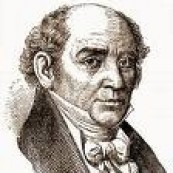

![Russian legends - Lazar Berman [7 CD]](http://static.classicalm.com/repository/collection-cover/small/263-img1318187682202830.jpg)
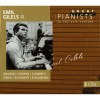
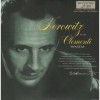
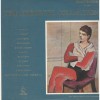
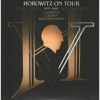
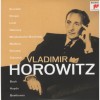

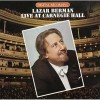

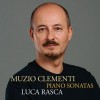
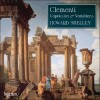
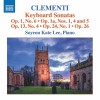
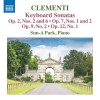
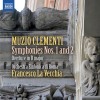
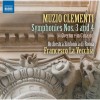
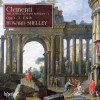
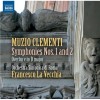
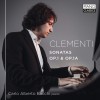
![Complete symphonies [2 CD]](http://static.classicalm.com/repository/composition-cover/small/10853-img1311523068295974.jpg)
